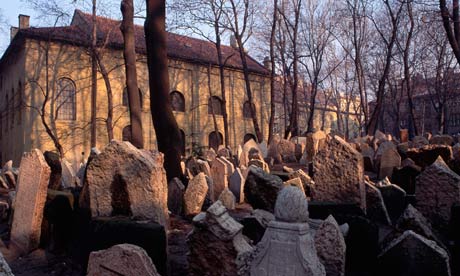
Imagine Dan Brown adorned with a PhD: that's Umberto Eco, who before he took up fiction 30 years ago in The Name of the Rose was a semiotician and a medieval literary scholar. Like Brown's The Da Vinci Code and The Lost Symbol, Eco's sixth novel, The Prague Cemetery, snakes along an underground trail that twists through the enlightened heresies and bigoted gospels respectively propagated by Freemasons and Illuminati, Jesuits and Jew-baiters, before hinting at an ideological conspiracy that underlines the deceits of contemporary politics.
The difference is that Brown devises a puzzle and goes on to solve it, whereas Eco's more highbrow pleasure lies in open-ended mystification. Brown wants us to believe in his cobweb of mystical coincidences and to trust his elucidation of those cryptic codes. Eco, however, is at best whimsically sceptical, at worst deliberately misleading: for him, the purpose of a story is to tell ingenious lies rather than to arrive at a drearily rational truth. Brown's recurrent hero is an academic turned detective, a so-called "symbologist" from Harvard whose special skill is the reassuring decipherment of riddles, while the protagonist of The Prague Cemetery is a professional forger, a malcontent who fakes documents for a living.
In this rambling, ramshackle picaresque novel, the bilious Captain Simone Simoni slithers across Europe in the pay of one secret service after another, claiming personal responsibility for the calumnies that provoked most of the political crises of the 19th century. He serves his apprenticeship during Italy's campaign to liberate itself from Austrian rule. Officially he joins the novelist Alexandre Dumas in embellishing the mystique of Garibaldi; secretly he demolishes the patriotic myth, exposing the fabled warrior as a short, bandy-legged mediocrity. Abandoning Sicily for Paris, he stirs up trouble during the Commune, and goes on to concoct the incriminating document that causes Dreyfus to be convicted of treason. Side excursions link him with the Turkish conman Osman Bey and with the Romanovs in their efforts to suppress the bomb-throwing nihilists. Simonini's customers and victims are all actual historical characters, which enables Eco to suggest that history is a tissue of fictions, not a tale told by an idiot but a text slickly pieced together by self-appointed authorities who should never be trusted.
Simonini also dabbles in diabolism, and enjoys hoaxing the hoaxer Leo Taxil, who in 1897 staged a perverse and sexually flagrant Black Mass to mock Freemasonry and the Catholic church. His masterpiece is a Gothic fantasy about a nocturnal gathering of rabbis who come together in the cemetery in the Prague ghetto, among upended gravestones that might be the pages of a chaotic, crumbling book, to avenge the humiliations of their race by planning a Jewish coup that will commandeer financial and political power. Elaborating their mad schemes, Simonini the crazed anti-Semite sketches the notorious "Protocols of the Elders of Zion", which Hitler called his "warrant for genocide".
Despite the venom, The Prague Cemetery is a literary exercise, a novel that contains a critique of its own artifice. Eco awards himself the capitalised status of Narrator, and tries to elucidate the maunderings of two less reliable narrators, Simonini and a priest who is his alter ego. Wittily self-conscious, Eco discourses on the difference between plot and story, and supplies a diagram of their parallel development to help us through the labyrinth. This is a book made from a garbling of other books, with Victor Hugo, Proust and Zola, among its mob of subsidiary characters.
For Eco, the undertaking may be playful, a study of noxious nonsense that is illustrated with some controversially nasty caricatures of greedy Jews. But some of the million copies of The Prague Cemetery already sold in Europe and South America have probably been read by fanatics and fantasists who are eager to be duped by the conspiracy theories that Eco sceptically demolishes. The chief rabbi of Rome has expressed alarm about the violence of Simonini's hatred, and a review in the Vatican newspaper worried about the zest with which the novel revives injurious stereotypes. The world we live in – economically shaky, politically feeble, menaced by zealots, with a fearful populace half-elated by the prospect of catastrophe yet still urgently searching for scapegoats – is only too similar to that described by Eco in his survey of 19th-century Europe. What may have begun as a learned game, a pseudo-historical farrago in the manner of Dumas and Hugo, at times seems dangerously and reprehensibly close to the truth.
Eco has said, a little snottily, that he wants to appeal even to those who have the bad taste "to take Don Brown seriously". Would it bother him if these credulous readers missed his postmodern irony and took The Prague Cemetery a little too seriously? History is a nightmare, and Simonini's enfevered babbling won't help us to awaken from it.

